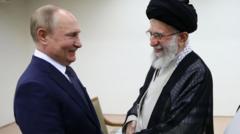Following a series of attacks initiated by Israel on Iran, the conflict has intensified with widespread retaliatory strikes from both nations, causing significant casualties and damage, particularly to critical infrastructure.
Escalating Tensions: Ongoing Israel-Iran Military Operations

Escalating Tensions: Ongoing Israel-Iran Military Operations
A timeline of the ongoing military conflict between Israel and Iran, highlighting significant strikes and retaliatory actions over recent days.
---
The conflict between Israel and Iran has significantly escalated, marked by a series of military strikes over the past days. Israel initiated operations on June 13, attacking key military sites in Iran, including nuclear facilities and critical command centers, prompting a fierce retaliatory response from Iranian armed forces.
**Key Developments:**
1. **June 13:** Israel executed airstrikes targeting military and nuclear installations across Iran. Reports indicate around 78 fatalities in Iran, including high-ranking military personnel and nuclear scientists.
2. **June 14:** Iran launched missiles at various locations in Israel, including a residential neighborhood in Rishon LeZion, leading to substantial civilian damage and casualties. Concurrently, Israel intensified its offensive by striking critical energy infrastructure, including a major gas field and refining facilities.
3. **June 15:** Iranian retaliation escalated with missile strikes affecting multiple Israeli cities, including Bat Yam and Tel Aviv. The Israeli government reported considerable damage and civilian losses in these areas.
4. **June 16:** The hostilities continued as Israel conducted operations near Tehran and targeted military criticals such as the airport infrastructure. Meanwhile, Iranian missiles caused deaths and injuries in central Israel, with calls for civilian evacuations from areas at risk of further strikes.
International responses have urged restraint, but the rhetoric from both nations remains combative, further complicating efforts towards a peaceful resolution. Both sides continue to intensify their military strategies, with significant implications for regional stability.
As the conflict unfolds, more than just military capabilities are being tested; the diplomatic landscape could shift dramatically depending on the reactions from global powers, further deepening the crisis in this historically volatile region.
The conflict between Israel and Iran has significantly escalated, marked by a series of military strikes over the past days. Israel initiated operations on June 13, attacking key military sites in Iran, including nuclear facilities and critical command centers, prompting a fierce retaliatory response from Iranian armed forces.
**Key Developments:**
1. **June 13:** Israel executed airstrikes targeting military and nuclear installations across Iran. Reports indicate around 78 fatalities in Iran, including high-ranking military personnel and nuclear scientists.
2. **June 14:** Iran launched missiles at various locations in Israel, including a residential neighborhood in Rishon LeZion, leading to substantial civilian damage and casualties. Concurrently, Israel intensified its offensive by striking critical energy infrastructure, including a major gas field and refining facilities.
3. **June 15:** Iranian retaliation escalated with missile strikes affecting multiple Israeli cities, including Bat Yam and Tel Aviv. The Israeli government reported considerable damage and civilian losses in these areas.
4. **June 16:** The hostilities continued as Israel conducted operations near Tehran and targeted military criticals such as the airport infrastructure. Meanwhile, Iranian missiles caused deaths and injuries in central Israel, with calls for civilian evacuations from areas at risk of further strikes.
International responses have urged restraint, but the rhetoric from both nations remains combative, further complicating efforts towards a peaceful resolution. Both sides continue to intensify their military strategies, with significant implications for regional stability.
As the conflict unfolds, more than just military capabilities are being tested; the diplomatic landscape could shift dramatically depending on the reactions from global powers, further deepening the crisis in this historically volatile region.























